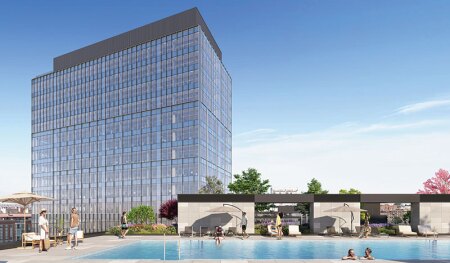Strict one-use-per-parcel zoning rules have long limited the growth of mixed-use projects in Spain, but the builders of a new office, residential, and commercial project in Madrid hope their example will pave the way for other integrated projects.
Developers at Inmobiliaria Colonial, a Spanish real estate multinational, have taken advantage of special rules governing a plot near Atocha Station, Madrid’s largest railway terminal, to erect their first mixed-use project. When completed, Madnum will offer about 970,000 square feet (90,000 sq m) of space for work, play, and living, including 606,000 square feet (56,300 sq m) of office space, 324,000 square feet (30,100 sq m) of residential space, and 39,000 square feet (3,600 sq m) of commercial space.
The residential aspect of the project is a departure for the $13 billion–plus firm. Although the listed office real estate investment trust manages an office portfolio of more than 18.3 million square feet (1.7 million sq m) of class A properties, mostly in Madrid, Barcelona, and Paris, Colonial executives see adding a residential component to the campus as an opportunity to capitalize on Madrid’s growing demand for apartments while also diversifying the risks of the project.
Madnum—Mad for Madrid, num for “now” in Latin—is one of the biggest developments in Atocha, a fading industrial neighborhood on the south side of Madrid where city urban planners have long seen an opportunity for renewal.
The complex is located just across street from the headquarters of Repsol, the Spanish petrochemical giant, and 800 feet (250 m) from the Méndez Álvaro interchange, a transit hub that offers good connections by subway, bus (urban and regional), and suburban train to the rest of the city and its suburbs. It is also 1.2 miles (2 km) from the Atocha Station, Madrid’s answer to New York City’s Grand Central Station.
But those good transportation links may matter less than expected: developers believe the 7,000 office users and 1,600 residents of the project’s 374 apartments will keep the complex humming day and night.

Madnum features 324,000 square feet (30,100 sq m) of residential space in addition to 606,000 square feet (56,300 sq m) of office space and 39,000 square feet (3,600 sq m) of commercial space. When Madnum is complete, residents will have access to a rooftop swimming pool with panoramic views of Madrid. (Inmobiliaria Colonial)
New Vision for a Neglected Neighborhood
Following Colonial’s acquisition of the two plots of underused industrial land in 2018, it hired Estudio Lamela Architects, a leading Madrid architecture firm, to work with the company to design a 970,000-square-foot (90,000 sq m) complex on a 246,000-square-foot (22,900 sq m) plot.
Estudio Lamela has designed a variety of high-profile projects throughout Europe, the Middle East, and Mexico. In Madrid, the firm is known principally for its work on the Colon Towers in the Plaza de Colón, and the 13 million-square-foot (1.2 million sq m) Terminal T4 at the Madrid Barajas Airport (in collaboration with the Richard Rogers Partnership).
The joint team held more than 50 meetings with various stakeholders and real estate experts. Team members also visited a variety of successful mixed-use projects in London, Copenhagen, Rotterdam, Amsterdam, and Malmö, including King’s Cross and Battersea Power Station in London, Maersk Tower in Copenhagen, and Westerdok Apartments in Amsterdam.
The study tour helped the team better understand the benefits of combining different uses within the same development. One key lesson it took back to Madrid was how a strong mixed-use project could help revitalize an area—one of the goals of the Madnum project for the semi-industrial Atocha neighborhood, which despite its good transportation links has had a reputation as one of the city’s neglected areas.
The executives also noted that office complexes that incorporate non-office uses can command higher rents than those that do not, because office tenants see advantages in renting space located within an ecosystem of shops, restaurants, and apartments.
The Long Road to Madnum
Despite some delays in securing all the permits, the project moved forward in 2019. Basic architectural drawings were completed that June, authorization for excavation and construction was granted in late 2019, and contractors began to dig in February 2020, the first stage in what was intended to be a 36-month construction project.
Then, only a few days into excavation, builders began to run into complications.
In mid-February, the COVID-19 pandemic reached Spain, knocking out a number of employees. Work continued, while the project strictly adhered to official restrictions on movement and nonessential work. Contractors estimate that the virus set them six months behind schedule.
In July 2020, workers dug up various archaeological objects—mostly Paleolithic arrowheads and rodent bones. Their discovery meant Colonial had to bring in a team of archaeologists to carry out a detailed survey, which continued until January 2021. Excavation and foundation work proceeded, but the contractors had to work around the scholars, further slowing progress.
Six months later, just as the archaeologists were leaving and the pace of work began to recover, a major snowstorm hit. In January 2021, Storm Filomena buried the site under nearly 23 inches (60 cm) of snow in less than 48 hours. That might not sound like a lot to residents of Buffalo, New York, but the snowfall had a major impact in a city that can go through the winter without seeing a single flake. Snowdrifts made access to the worksite impossible for a few days, and because the substrate of the plot is made up of slow-draining clay, enormous drainage issues arose once the snow and ice melted. Special access roads had to be built and tons of salt poured before work could resume.
Eventually, Colonial’s contractors got back on track, but now in an environment of steadily increasing materials costs fueled by rising energy prices, supply chain disturbances, and interest rate hikes.Colonial tried to keep costs under control through a variety of measures on and off the worksite. The firm divided its site management into below-ground and above-ground phases for both the residential and office components to streamline the building permit applications process, as well as to encourage competition between contractors in order to mitigate volatile materials price fluctuation.
The firm also opted for prefabricated bathrooms in the apartments and agreed to let OHLA, one of its builders, use a new technology to monitor how well the building’s concrete was setting. OHLA used sensors embedded in concrete slabs to measure their internal temperature and humidity. Being able to obtain real-time data on the strength and resilience of the material via a mobile phone app helped speed up construction.
In its marketing, Colonial took a page out of the King’s Cross playbook by not only looking for anchor tenants for its retail space and multinationals for its offices, but also reaching out to two important residential rental markets—young people who cannot afford to buy property in Madrid and professionals in need of short- and medium-term accommodations.
Staying Green
Despite the pressure to bring the complex to market, Colonial says it has remained committed to high environmental, social, and governance (ESG) standards.
Environmental features include two landscaped indoor areas, one on the residential side of the project and one on the office side, which together will cover 69,000 square feet (6,400 sq m) and include green roofs, plant walls, and planters. Although the greenery should be a welcome addition to what is otherwise a fairly treeless area, it should not require much water because developers intend to plant mostly native species.
Nor is the green attitude only skin deep. When completed, the buildings will have a small carbon footprint and near zero energy consumption—a zero-kilogram carbon dioxide equivalent per year of emissions once they are in operation. A cistern will be installed in the basement to harvest rainwater—a good thing in a city that experiences frequent droughts. Eventually, Colonial executives plan to have the buildings certified BREEAM Very Good on the residential side and LEED Gold/Platinum for the office building. In addition, some workers may choose to live at the campus, further reducing the community’s collective carbon footprint.
Colonial executives say they wanted to make the project even greener and more user friendly but strict town planning rules required extra time that limited their ability to do so. For example, COVID spurred a tremendous demand for balconies, but the time required for approvals process and the advanced stage of construction made it impossible to adjust the design and stay on schedule.
Out-of-date zoning rules also mandated that Colonial create 900 parking spaces at Madnum, despite its excellent transportation connections and projections that Madrileños will drive less and less in the coming years. Further, Colonial notes that the spaces may prove to be dinosaur nests because the garages were not equipped with the infrastructure needed to charge 900 electric cars.
City officials are very positive about the project’s outcome. Mariano Fuentos Sedano, delegate for urban development for Madrid, said he hopes it is the first of many successful undertakings with Colonial.
ULI sees a lot to like in the Madnum project as well. Madnum is a development that not only increases the stock of class A buildings in the Méndez Álvaro district, but also will shape the future of the neighborhood, says Alberto Valls, managing partner of real estate at Deloitte Spain and EMEA, and chair of ULI Madrid. Madnum, he says, is “state-of-the-art in mixed-use development combined with the highest ESG standards. It is a top ambassador of urban regeneration projects, enhancing new ways of working and living.”








